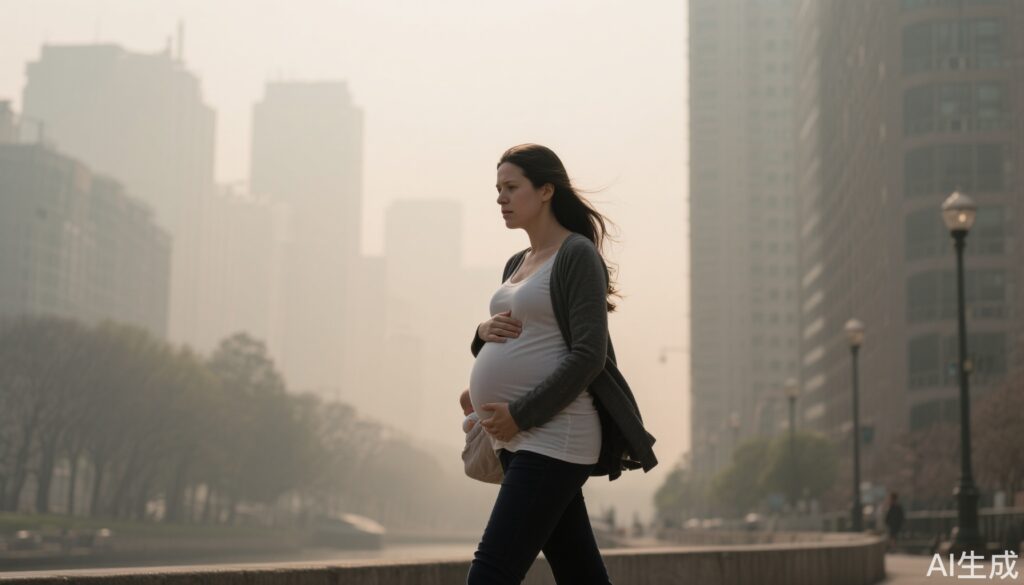For decades, public health messaging has warned us about the dangers of air pollution—how it affects our lungs, heart, and even our brains. But a new frontier of research is exploring an unexpected consequence: the risk of childhood obesity stemming from exposure to air pollution before a child is even born. Recent findings from a sweeping European study suggest that the air a pregnant woman breathes—specifically, exposure to fine particulate matter known as PM2.5—may set the stage for her child’s weight and metabolic health years down the line.
Background: The Growing Problem of Childhood Obesity
Childhood obesity is more than a cosmetic issue; it’s a complex, multifactorial condition linked to higher risks of type 2 diabetes, heart disease, and lifelong health challenges. The World Health Organization estimates that over 39 million children under five were overweight or obese in 2022, and rates are climbing globally. While diet, physical activity, and genetics play established roles, scientists are increasingly recognizing the influence of early-life environmental exposures—including air pollution—on obesity risk.
Understanding PM2.5: What Makes This Air Pollutant So Harmful?
PM2.5 refers to particulate matter smaller than 2.5 micrometers in diameter—so tiny that it can penetrate deep into the lungs and even enter the bloodstream. Sources include vehicle emissions, industrial processes, wildfires, and household heating. The health impacts of PM2.5 are well-documented, ranging from respiratory and cardiovascular disease to adverse pregnancy outcomes. But can it really influence whether a child becomes overweight or obese?
The Landmark European Study: What the Data Show
A large-scale investigation led by Dr. Sarah Warkentin and colleagues at the Barcelona Institute for Global Health recently published in Environment International pooled data from 10 birth cohorts spanning eight European countries. The study tracked over 37,000 mother-child pairs from pregnancy through the children’s early teenage years, examining the relationship between prenatal and postnatal air pollution exposure and children’s body mass index (BMI) and overweight/obesity status.
Key findings include:
- Children whose mothers were exposed to higher levels of PM2.5 during pregnancy were 23% more likely to be overweight or obese compared to those with lower exposure.
- The strongest link was seen in children aged 9 to 12 years, who had a 29% higher risk if their prenatal PM2.5 exposure was high.
- This association remained significant after adjusting for factors like maternal education, pre-pregnancy BMI, and socioeconomic status.
- No consistent link was found between childhood obesity and exposure to nitrogen dioxide (NO₂), another major air pollutant.
- Interestingly, postnatal exposure to PM2.5 did not show a significant impact on childhood obesity risk.
| Age Group | Obesity/Overweight Prevalence (High PM2.5 Exposure) | Odds Ratio for Obesity/Overweight |
|---|---|---|
| 0–2 years | 12.3% – 40.5% | 1.23 |
| 2–5 years | 16.7% – 35.3% | 1.18 |
| 5–9 years | 12.5% – 40.7% | 1.21 |
| 9–12 years | 10.7% – 43.8% | 1.29 |
Case Vignette: Olivia’s Story
Olivia, a 10-year-old girl from Northern Italy, was born to a mother who lived in a city with some of the highest PM2.5 levels in Europe. Despite a healthy diet and regular activity, Olivia struggled with her weight from an early age. Her mother, Emily, recalls, “I never smoked, ate well during pregnancy, and followed all the advice. I never imagined that the air we breathed could play a role.” Olivia’s experience echoes the findings of the European study, which pinpointed Italian cities as hotspots for both air pollution and higher childhood obesity rates.
How Might Air Pollution Influence Obesity?
Experts speculate several biological mechanisms:
- Oxidative Stress and Inflammation: PM2.5 can trigger inflammation and oxidative stress in the mother, which may affect the developing fetus.
- Placental Disruption: Air pollution may impair placental function, affecting nutrient delivery and fetal growth patterns.
- Hormonal Disruption: Pollutants can alter hormone levels that regulate fetal metabolism and fat storage.
- Epigenetic Changes: Environmental exposures during pregnancy might cause lasting gene expression changes related to weight regulation.
Dr. Martine Vrijheid, director of ISGlobal’s Environment and Health over the Lifecourse program, explains, “Exposure to pollution during pregnancy has been linked to reduced fetal growth and low birth weight. These same processes—oxidative stress, inflammation, placental problems, or hormonal disruptions—could also increase the risk of obesity during childhood.”
Common Misconceptions and Potentially Harmful Behaviors
- “Air pollution only affects the lungs.” In reality, fine particles like PM2.5 reach beyond the lungs, influencing systemic inflammation and metabolic health.
- “Indoor air is always safe.” Indoor air can also carry PM2.5 from outdoor sources or household activities like cooking and heating.
- “Short-term exposure isn’t harmful.” Even short bursts of high exposure during critical windows like pregnancy can have lasting effects.
- “If I live outside a big city, I’m safe.” PM2.5 can travel long distances, affecting suburban and rural areas, especially near highways or industry.
What Pregnant Women—and Families—Can Do
While individuals can’t control all environmental exposures, there are steps families and communities can take:
- Monitor air quality: Use apps or local government sites to check daily air pollution levels, and avoid outdoor activities when PM2.5 is high.
- Ventilate wisely: Open windows during low-pollution times and consider air purifiers with HEPA filters.
- Choose commuting routes carefully: Walk or cycle away from busy roads when possible.
- Advocate for cleaner air: Support policies that reduce vehicle emissions and promote green spaces.
- Healthcare provider guidance: Pregnant women should discuss environmental risks with their obstetricians, especially if living in high-pollution areas.
Expert Insights: The Broader Public Health Perspective
Dr. Sarah Warkentin, lead author of the recent study, emphasizes that the findings should prompt action at both individual and societal levels: “Our results indicate that the gestational period may represent a particularly vulnerable window for the risk of childhood obesity. However, further research is needed to precisely identify the critical periods during which exposure to air pollution might influence this risk.”
Public health officials echo the importance of reducing air pollution at the source—through stricter emission standards, cleaner transportation, and urban planning—to protect the most vulnerable.
Conclusion: A Call for Awareness and Action
The link between prenatal air pollution exposure and childhood obesity adds a new layer of urgency to the fight for clean air. As research continues to unravel how our environment shapes our health even before birth, families and policymakers must work together to minimize risks and give every child a healthier start.
References
- Warkentin S, Fossati S, Marquez S, et al. Ambient air pollution and childhood obesity from infancy to late childhood: An individual participant data meta-analysis of 10 European birth cohorts. Environment International. 2025;200:109527. doi:10.1016/j.envint.2025.109527 IF: 9.7 Q1
- Exposure to particulate matter during pregnancy is associated with an increased risk of childhood obesity. Barcelona Institute for Global Health. June 25, 2025. Accessed July 1, 2025. https://www.eurekalert.org/news-releases/1088167
- World Health Organization. Obesity and overweight. Updated March 2024. https://www.who.int/news-room/fact-sheets/detail/obesity-and-overweight


